Social Policy on Mental Health in Australia
VerifiedAdded on 2019/11/19
|9
|2548
|164
Essay
AI Summary
This essay examines Australia's social policy on mental health, focusing on the National Mental Health Policy (NMHP) and its evolution from the Australian Mental Health Strategy (AMHS). It discusses the policy's aims to improve mental health, reduce the impact of mental disorders, and ensure equitable access to services. The essay highlights the policy's successes in improving service access and quality, but also points out shortcomings, such as insufficient funding and the need for a more comprehensive approach to address diverse mental health issues. Recommendations include increased funding, improved housing support, equitable workplace participation for individuals with mental health conditions, and better integration of mental health services within the criminal justice system. The conclusion emphasizes the importance of continued efforts to fully implement the NMHP and achieve its goals of social inclusion and improved mental health outcomes for all Australians.

Running Head: SOCIAL POLICY ON MENTAL HEALTH IN AUSTRALIA 1
Social Policy on Mental Health in Australia
Name
Institution
Social Policy on Mental Health in Australia
Name
Institution
Paraphrase This Document
Need a fresh take? Get an instant paraphrase of this document with our AI Paraphraser
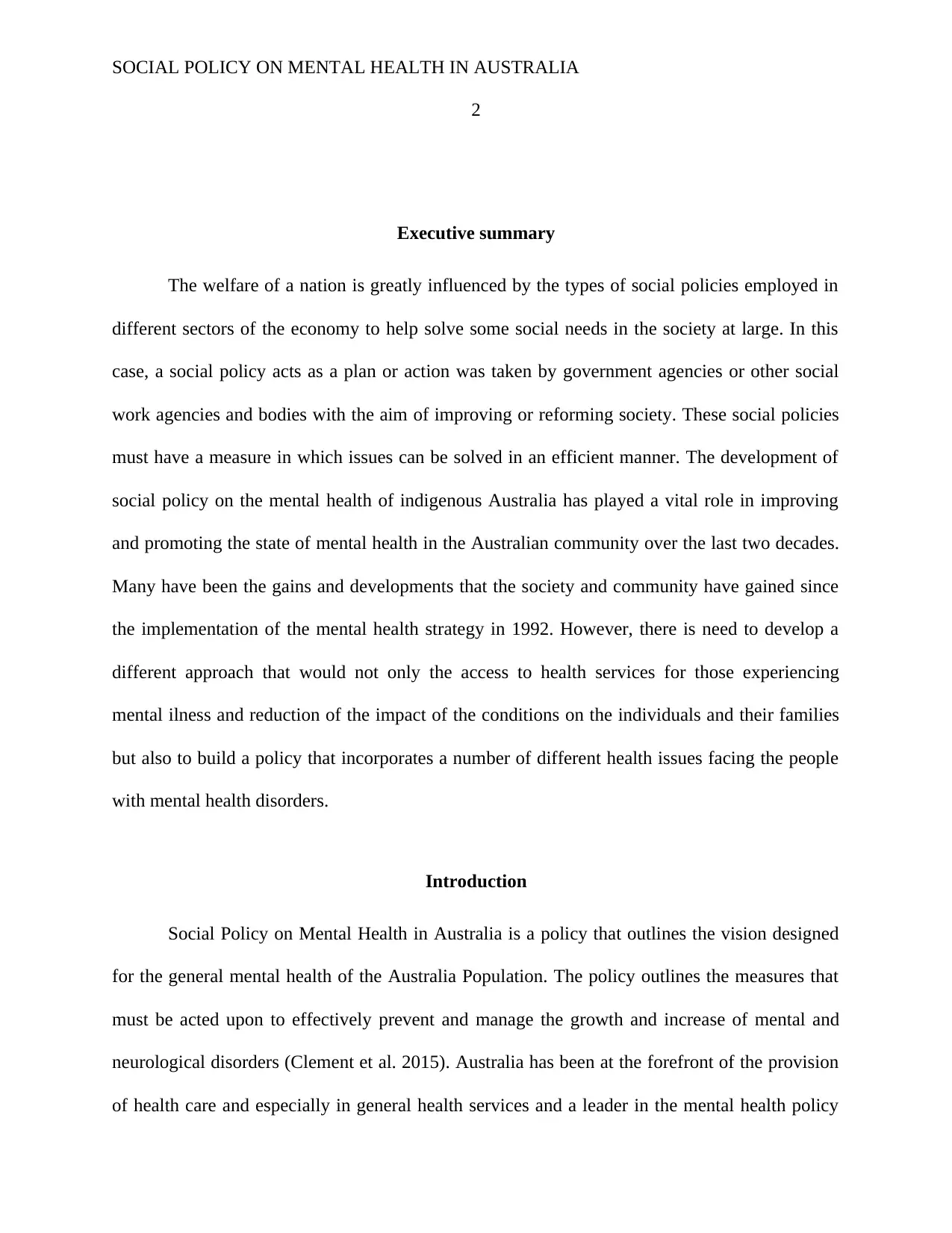
SOCIAL POLICY ON MENTAL HEALTH IN AUSTRALIA
2
Executive summary
The welfare of a nation is greatly influenced by the types of social policies employed in
different sectors of the economy to help solve some social needs in the society at large. In this
case, a social policy acts as a plan or action was taken by government agencies or other social
work agencies and bodies with the aim of improving or reforming society. These social policies
must have a measure in which issues can be solved in an efficient manner. The development of
social policy on the mental health of indigenous Australia has played a vital role in improving
and promoting the state of mental health in the Australian community over the last two decades.
Many have been the gains and developments that the society and community have gained since
the implementation of the mental health strategy in 1992. However, there is need to develop a
different approach that would not only the access to health services for those experiencing
mental ilness and reduction of the impact of the conditions on the individuals and their families
but also to build a policy that incorporates a number of different health issues facing the people
with mental health disorders.
Introduction
Social Policy on Mental Health in Australia is a policy that outlines the vision designed
for the general mental health of the Australia Population. The policy outlines the measures that
must be acted upon to effectively prevent and manage the growth and increase of mental and
neurological disorders (Clement et al. 2015). Australia has been at the forefront of the provision
of health care and especially in general health services and a leader in the mental health policy
2
Executive summary
The welfare of a nation is greatly influenced by the types of social policies employed in
different sectors of the economy to help solve some social needs in the society at large. In this
case, a social policy acts as a plan or action was taken by government agencies or other social
work agencies and bodies with the aim of improving or reforming society. These social policies
must have a measure in which issues can be solved in an efficient manner. The development of
social policy on the mental health of indigenous Australia has played a vital role in improving
and promoting the state of mental health in the Australian community over the last two decades.
Many have been the gains and developments that the society and community have gained since
the implementation of the mental health strategy in 1992. However, there is need to develop a
different approach that would not only the access to health services for those experiencing
mental ilness and reduction of the impact of the conditions on the individuals and their families
but also to build a policy that incorporates a number of different health issues facing the people
with mental health disorders.
Introduction
Social Policy on Mental Health in Australia is a policy that outlines the vision designed
for the general mental health of the Australia Population. The policy outlines the measures that
must be acted upon to effectively prevent and manage the growth and increase of mental and
neurological disorders (Clement et al. 2015). Australia has been at the forefront of the provision
of health care and especially in general health services and a leader in the mental health policy
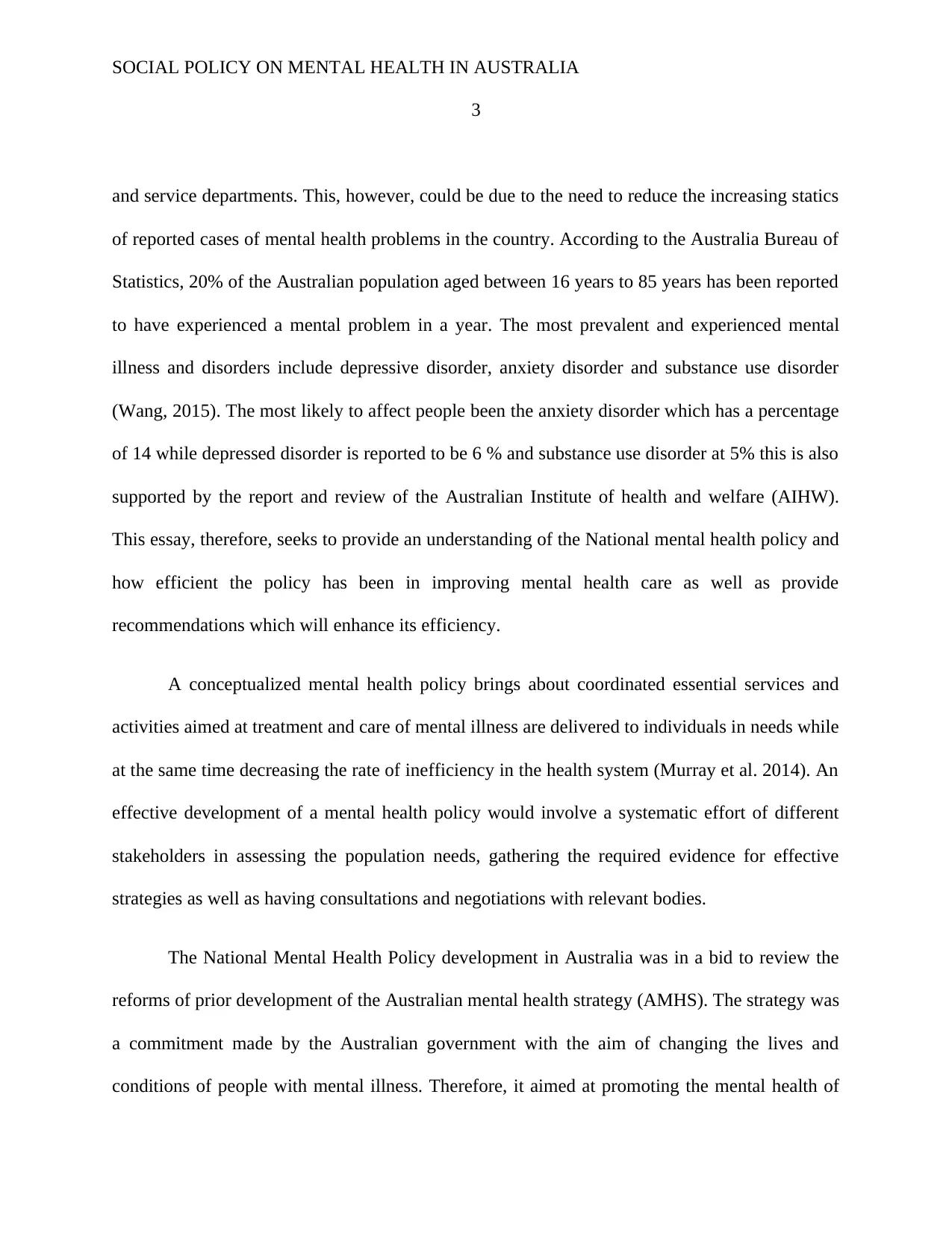
SOCIAL POLICY ON MENTAL HEALTH IN AUSTRALIA
3
and service departments. This, however, could be due to the need to reduce the increasing statics
of reported cases of mental health problems in the country. According to the Australia Bureau of
Statistics, 20% of the Australian population aged between 16 years to 85 years has been reported
to have experienced a mental problem in a year. The most prevalent and experienced mental
illness and disorders include depressive disorder, anxiety disorder and substance use disorder
(Wang, 2015). The most likely to affect people been the anxiety disorder which has a percentage
of 14 while depressed disorder is reported to be 6 % and substance use disorder at 5% this is also
supported by the report and review of the Australian Institute of health and welfare (AIHW).
This essay, therefore, seeks to provide an understanding of the National mental health policy and
how efficient the policy has been in improving mental health care as well as provide
recommendations which will enhance its efficiency.
A conceptualized mental health policy brings about coordinated essential services and
activities aimed at treatment and care of mental illness are delivered to individuals in needs while
at the same time decreasing the rate of inefficiency in the health system (Murray et al. 2014). An
effective development of a mental health policy would involve a systematic effort of different
stakeholders in assessing the population needs, gathering the required evidence for effective
strategies as well as having consultations and negotiations with relevant bodies.
The National Mental Health Policy development in Australia was in a bid to review the
reforms of prior development of the Australian mental health strategy (AMHS). The strategy was
a commitment made by the Australian government with the aim of changing the lives and
conditions of people with mental illness. Therefore, it aimed at promoting the mental health of
3
and service departments. This, however, could be due to the need to reduce the increasing statics
of reported cases of mental health problems in the country. According to the Australia Bureau of
Statistics, 20% of the Australian population aged between 16 years to 85 years has been reported
to have experienced a mental problem in a year. The most prevalent and experienced mental
illness and disorders include depressive disorder, anxiety disorder and substance use disorder
(Wang, 2015). The most likely to affect people been the anxiety disorder which has a percentage
of 14 while depressed disorder is reported to be 6 % and substance use disorder at 5% this is also
supported by the report and review of the Australian Institute of health and welfare (AIHW).
This essay, therefore, seeks to provide an understanding of the National mental health policy and
how efficient the policy has been in improving mental health care as well as provide
recommendations which will enhance its efficiency.
A conceptualized mental health policy brings about coordinated essential services and
activities aimed at treatment and care of mental illness are delivered to individuals in needs while
at the same time decreasing the rate of inefficiency in the health system (Murray et al. 2014). An
effective development of a mental health policy would involve a systematic effort of different
stakeholders in assessing the population needs, gathering the required evidence for effective
strategies as well as having consultations and negotiations with relevant bodies.
The National Mental Health Policy development in Australia was in a bid to review the
reforms of prior development of the Australian mental health strategy (AMHS). The strategy was
a commitment made by the Australian government with the aim of changing the lives and
conditions of people with mental illness. Therefore, it aimed at promoting the mental health of
⊘ This is a preview!⊘
Do you want full access?
Subscribe today to unlock all pages.

Trusted by 1+ million students worldwide
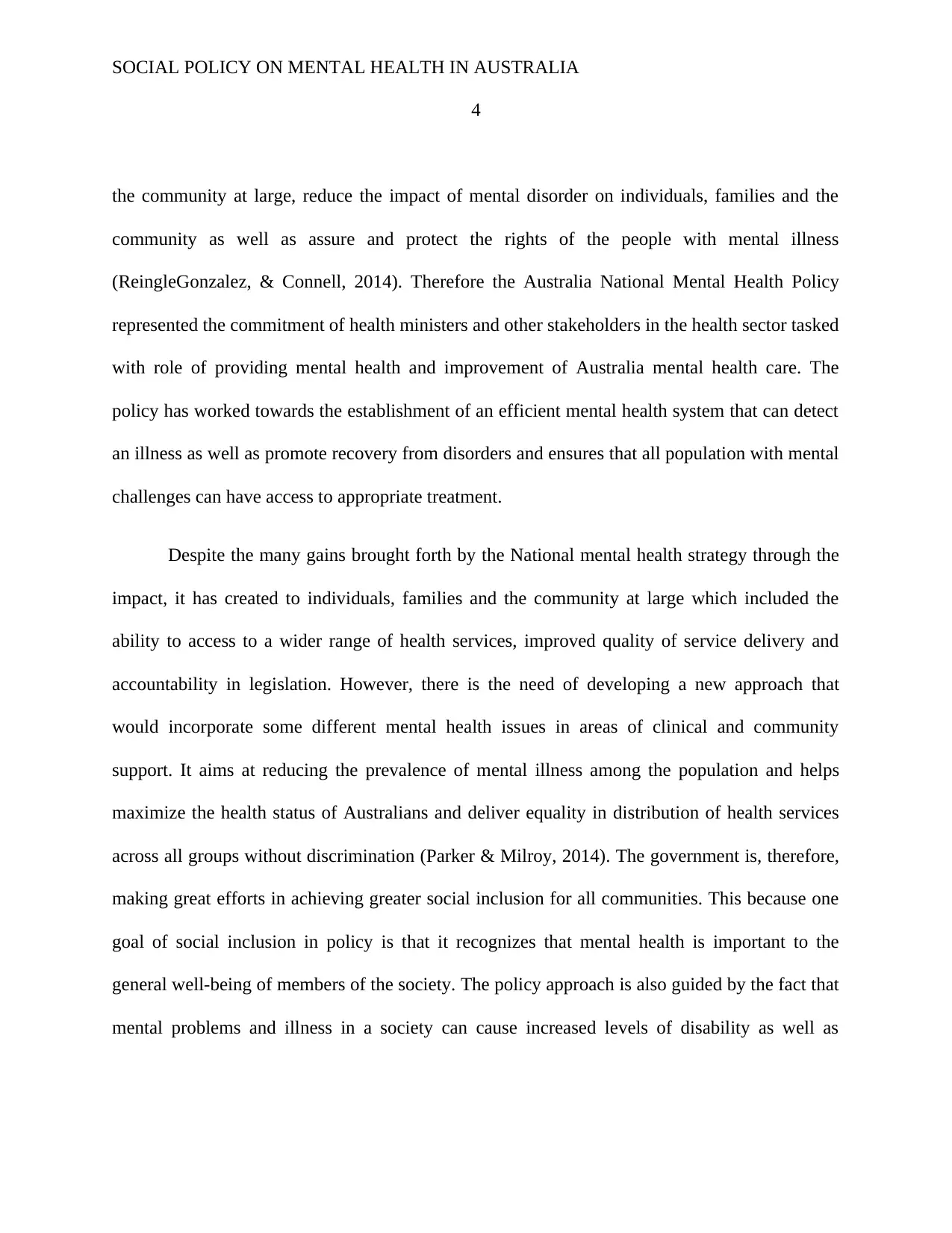
SOCIAL POLICY ON MENTAL HEALTH IN AUSTRALIA
4
the community at large, reduce the impact of mental disorder on individuals, families and the
community as well as assure and protect the rights of the people with mental illness
(ReingleGonzalez, & Connell, 2014). Therefore the Australia National Mental Health Policy
represented the commitment of health ministers and other stakeholders in the health sector tasked
with role of providing mental health and improvement of Australia mental health care. The
policy has worked towards the establishment of an efficient mental health system that can detect
an illness as well as promote recovery from disorders and ensures that all population with mental
challenges can have access to appropriate treatment.
Despite the many gains brought forth by the National mental health strategy through the
impact, it has created to individuals, families and the community at large which included the
ability to access to a wider range of health services, improved quality of service delivery and
accountability in legislation. However, there is the need of developing a new approach that
would incorporate some different mental health issues in areas of clinical and community
support. It aims at reducing the prevalence of mental illness among the population and helps
maximize the health status of Australians and deliver equality in distribution of health services
across all groups without discrimination (Parker & Milroy, 2014). The government is, therefore,
making great efforts in achieving greater social inclusion for all communities. This because one
goal of social inclusion in policy is that it recognizes that mental health is important to the
general well-being of members of the society. The policy approach is also guided by the fact that
mental problems and illness in a society can cause increased levels of disability as well as
4
the community at large, reduce the impact of mental disorder on individuals, families and the
community as well as assure and protect the rights of the people with mental illness
(ReingleGonzalez, & Connell, 2014). Therefore the Australia National Mental Health Policy
represented the commitment of health ministers and other stakeholders in the health sector tasked
with role of providing mental health and improvement of Australia mental health care. The
policy has worked towards the establishment of an efficient mental health system that can detect
an illness as well as promote recovery from disorders and ensures that all population with mental
challenges can have access to appropriate treatment.
Despite the many gains brought forth by the National mental health strategy through the
impact, it has created to individuals, families and the community at large which included the
ability to access to a wider range of health services, improved quality of service delivery and
accountability in legislation. However, there is the need of developing a new approach that
would incorporate some different mental health issues in areas of clinical and community
support. It aims at reducing the prevalence of mental illness among the population and helps
maximize the health status of Australians and deliver equality in distribution of health services
across all groups without discrimination (Parker & Milroy, 2014). The government is, therefore,
making great efforts in achieving greater social inclusion for all communities. This because one
goal of social inclusion in policy is that it recognizes that mental health is important to the
general well-being of members of the society. The policy approach is also guided by the fact that
mental problems and illness in a society can cause increased levels of disability as well as
Paraphrase This Document
Need a fresh take? Get an instant paraphrase of this document with our AI Paraphraser
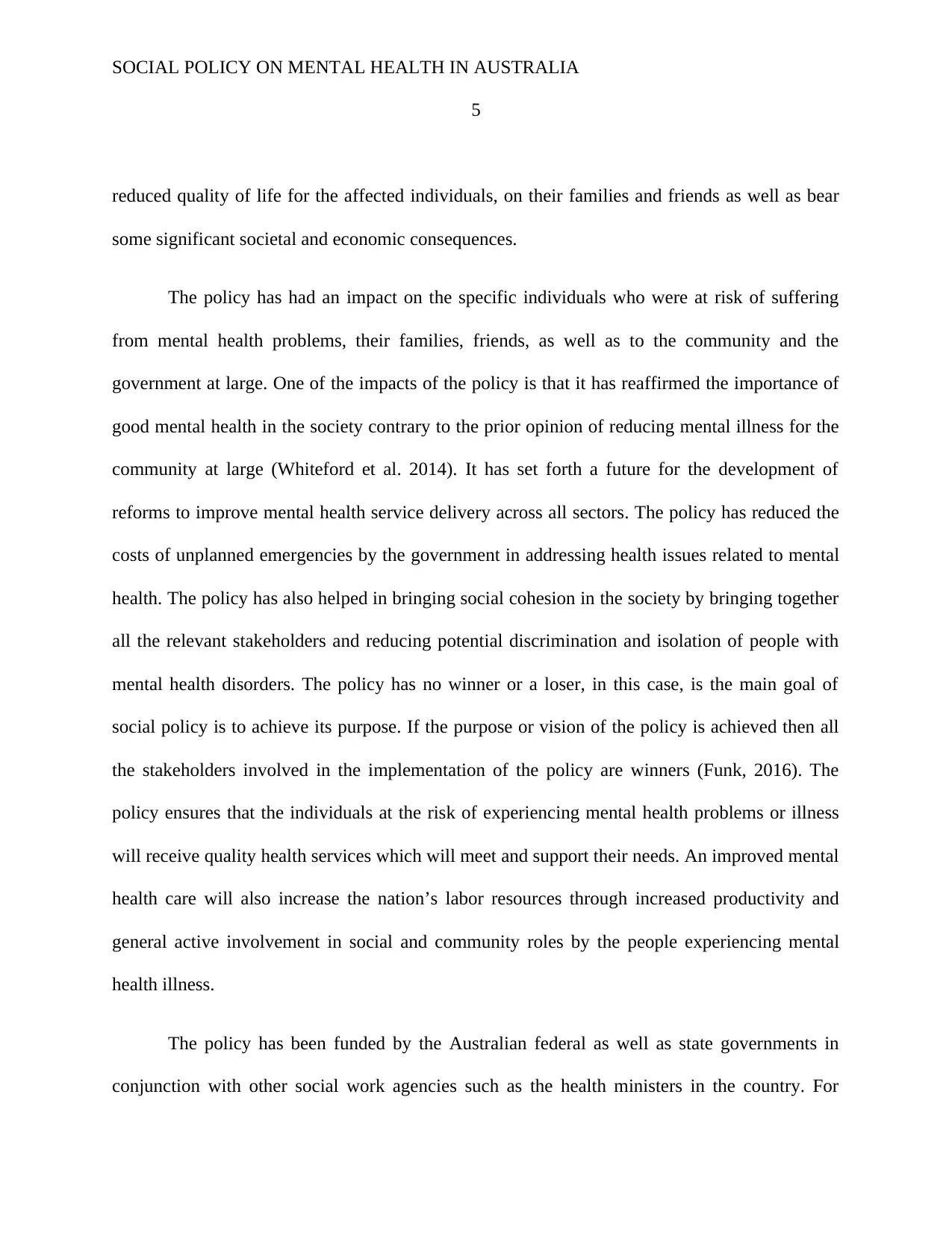
SOCIAL POLICY ON MENTAL HEALTH IN AUSTRALIA
5
reduced quality of life for the affected individuals, on their families and friends as well as bear
some significant societal and economic consequences.
The policy has had an impact on the specific individuals who were at risk of suffering
from mental health problems, their families, friends, as well as to the community and the
government at large. One of the impacts of the policy is that it has reaffirmed the importance of
good mental health in the society contrary to the prior opinion of reducing mental illness for the
community at large (Whiteford et al. 2014). It has set forth a future for the development of
reforms to improve mental health service delivery across all sectors. The policy has reduced the
costs of unplanned emergencies by the government in addressing health issues related to mental
health. The policy has also helped in bringing social cohesion in the society by bringing together
all the relevant stakeholders and reducing potential discrimination and isolation of people with
mental health disorders. The policy has no winner or a loser, in this case, is the main goal of
social policy is to achieve its purpose. If the purpose or vision of the policy is achieved then all
the stakeholders involved in the implementation of the policy are winners (Funk, 2016). The
policy ensures that the individuals at the risk of experiencing mental health problems or illness
will receive quality health services which will meet and support their needs. An improved mental
health care will also increase the nation’s labor resources through increased productivity and
general active involvement in social and community roles by the people experiencing mental
health illness.
The policy has been funded by the Australian federal as well as state governments in
conjunction with other social work agencies such as the health ministers in the country. For
5
reduced quality of life for the affected individuals, on their families and friends as well as bear
some significant societal and economic consequences.
The policy has had an impact on the specific individuals who were at risk of suffering
from mental health problems, their families, friends, as well as to the community and the
government at large. One of the impacts of the policy is that it has reaffirmed the importance of
good mental health in the society contrary to the prior opinion of reducing mental illness for the
community at large (Whiteford et al. 2014). It has set forth a future for the development of
reforms to improve mental health service delivery across all sectors. The policy has reduced the
costs of unplanned emergencies by the government in addressing health issues related to mental
health. The policy has also helped in bringing social cohesion in the society by bringing together
all the relevant stakeholders and reducing potential discrimination and isolation of people with
mental health disorders. The policy has no winner or a loser, in this case, is the main goal of
social policy is to achieve its purpose. If the purpose or vision of the policy is achieved then all
the stakeholders involved in the implementation of the policy are winners (Funk, 2016). The
policy ensures that the individuals at the risk of experiencing mental health problems or illness
will receive quality health services which will meet and support their needs. An improved mental
health care will also increase the nation’s labor resources through increased productivity and
general active involvement in social and community roles by the people experiencing mental
health illness.
The policy has been funded by the Australian federal as well as state governments in
conjunction with other social work agencies such as the health ministers in the country. For
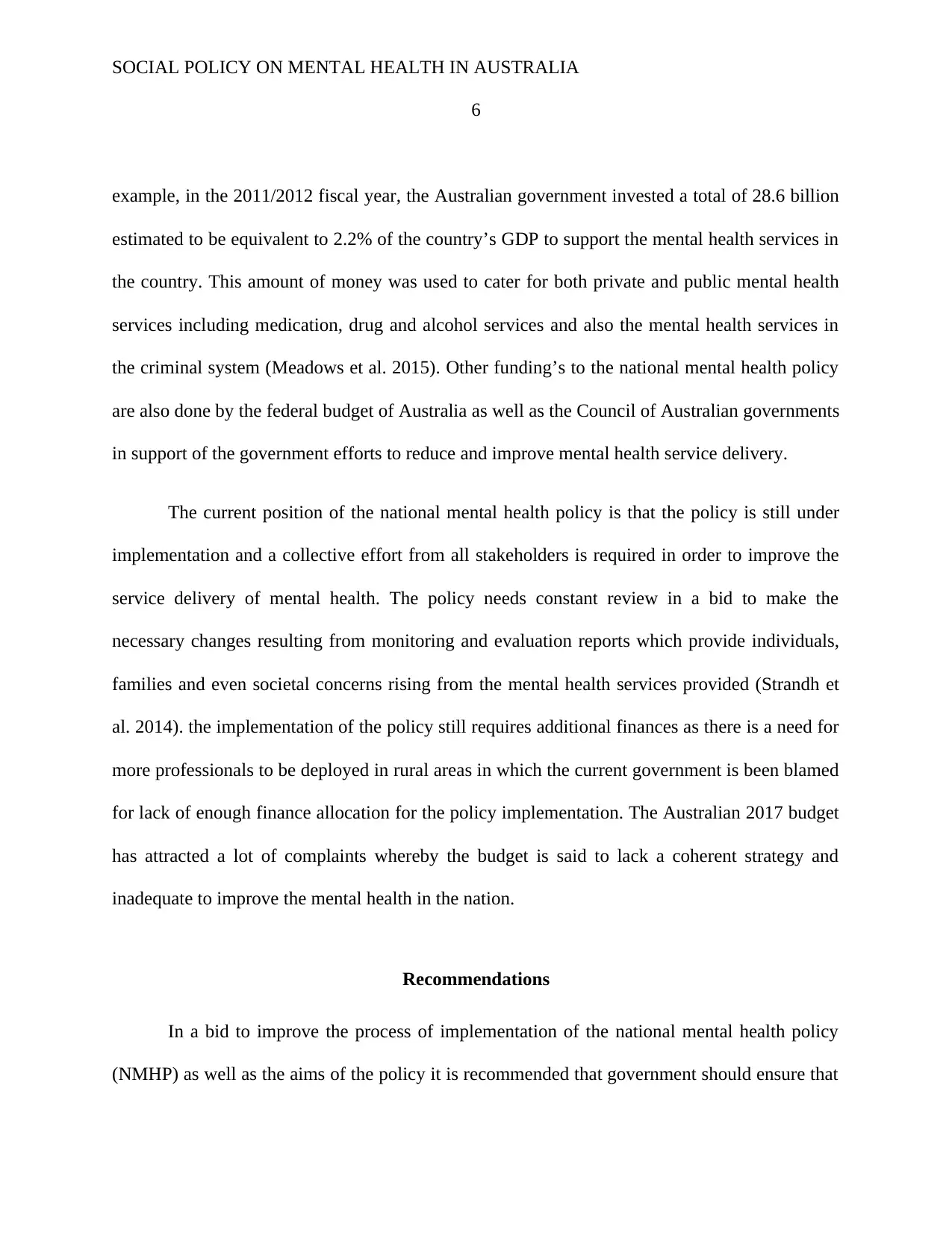
SOCIAL POLICY ON MENTAL HEALTH IN AUSTRALIA
6
example, in the 2011/2012 fiscal year, the Australian government invested a total of 28.6 billion
estimated to be equivalent to 2.2% of the country’s GDP to support the mental health services in
the country. This amount of money was used to cater for both private and public mental health
services including medication, drug and alcohol services and also the mental health services in
the criminal system (Meadows et al. 2015). Other funding’s to the national mental health policy
are also done by the federal budget of Australia as well as the Council of Australian governments
in support of the government efforts to reduce and improve mental health service delivery.
The current position of the national mental health policy is that the policy is still under
implementation and a collective effort from all stakeholders is required in order to improve the
service delivery of mental health. The policy needs constant review in a bid to make the
necessary changes resulting from monitoring and evaluation reports which provide individuals,
families and even societal concerns rising from the mental health services provided (Strandh et
al. 2014). the implementation of the policy still requires additional finances as there is a need for
more professionals to be deployed in rural areas in which the current government is been blamed
for lack of enough finance allocation for the policy implementation. The Australian 2017 budget
has attracted a lot of complaints whereby the budget is said to lack a coherent strategy and
inadequate to improve the mental health in the nation.
Recommendations
In a bid to improve the process of implementation of the national mental health policy
(NMHP) as well as the aims of the policy it is recommended that government should ensure that
6
example, in the 2011/2012 fiscal year, the Australian government invested a total of 28.6 billion
estimated to be equivalent to 2.2% of the country’s GDP to support the mental health services in
the country. This amount of money was used to cater for both private and public mental health
services including medication, drug and alcohol services and also the mental health services in
the criminal system (Meadows et al. 2015). Other funding’s to the national mental health policy
are also done by the federal budget of Australia as well as the Council of Australian governments
in support of the government efforts to reduce and improve mental health service delivery.
The current position of the national mental health policy is that the policy is still under
implementation and a collective effort from all stakeholders is required in order to improve the
service delivery of mental health. The policy needs constant review in a bid to make the
necessary changes resulting from monitoring and evaluation reports which provide individuals,
families and even societal concerns rising from the mental health services provided (Strandh et
al. 2014). the implementation of the policy still requires additional finances as there is a need for
more professionals to be deployed in rural areas in which the current government is been blamed
for lack of enough finance allocation for the policy implementation. The Australian 2017 budget
has attracted a lot of complaints whereby the budget is said to lack a coherent strategy and
inadequate to improve the mental health in the nation.
Recommendations
In a bid to improve the process of implementation of the national mental health policy
(NMHP) as well as the aims of the policy it is recommended that government should ensure that
⊘ This is a preview!⊘
Do you want full access?
Subscribe today to unlock all pages.

Trusted by 1+ million students worldwide

SOCIAL POLICY ON MENTAL HEALTH IN AUSTRALIA
7
those at the risk of experiencing mental illness will receive services that meet their clinical health
needs and other social support needs. The government and other stakeholders should add more
capital resources and invest more funds in mental health care (World Health Organization,
2014). The government should also provide the required housing properties and support for
individual with or at risk of experiencing mental health illness. Such a move will reduce
discrimination and stigma experienced by the people experiencing mental illness.
When it comes to changes in work places, it is recommended that the employers in different
sectors should ensure equitable participation in work for people with mental health problems.
Most times these people feel discriminated against at work place and therefore to achieve social
inclusion these measures have to be put in place (Fazel et al. 2014). For the individuals in the
criminal justice sector, the system should provide and ensure that people diagnosed with mental
health issues in their system participates and contributes to the community since in most cases
these people in courts are usually over represented. The policy of mental health is, therefore, a
collective policy which affects not only the individual at the risk of mental health illness but also
their families as well as the community at large.
Conclusion
The efforts involved in development and implementation of mental health social policy in
Australia has been vital in improving the state of mental health in the country. For instance, the
Australian Mental Health Strategy (AMHS 2008) has provided a platform for the development of
the National Mental Health Social Policy (NMHSP). It is a review of the former social mental
7
those at the risk of experiencing mental illness will receive services that meet their clinical health
needs and other social support needs. The government and other stakeholders should add more
capital resources and invest more funds in mental health care (World Health Organization,
2014). The government should also provide the required housing properties and support for
individual with or at risk of experiencing mental health illness. Such a move will reduce
discrimination and stigma experienced by the people experiencing mental illness.
When it comes to changes in work places, it is recommended that the employers in different
sectors should ensure equitable participation in work for people with mental health problems.
Most times these people feel discriminated against at work place and therefore to achieve social
inclusion these measures have to be put in place (Fazel et al. 2014). For the individuals in the
criminal justice sector, the system should provide and ensure that people diagnosed with mental
health issues in their system participates and contributes to the community since in most cases
these people in courts are usually over represented. The policy of mental health is, therefore, a
collective policy which affects not only the individual at the risk of mental health illness but also
their families as well as the community at large.
Conclusion
The efforts involved in development and implementation of mental health social policy in
Australia has been vital in improving the state of mental health in the country. For instance, the
Australian Mental Health Strategy (AMHS 2008) has provided a platform for the development of
the National Mental Health Social Policy (NMHSP). It is a review of the former social mental
Paraphrase This Document
Need a fresh take? Get an instant paraphrase of this document with our AI Paraphraser
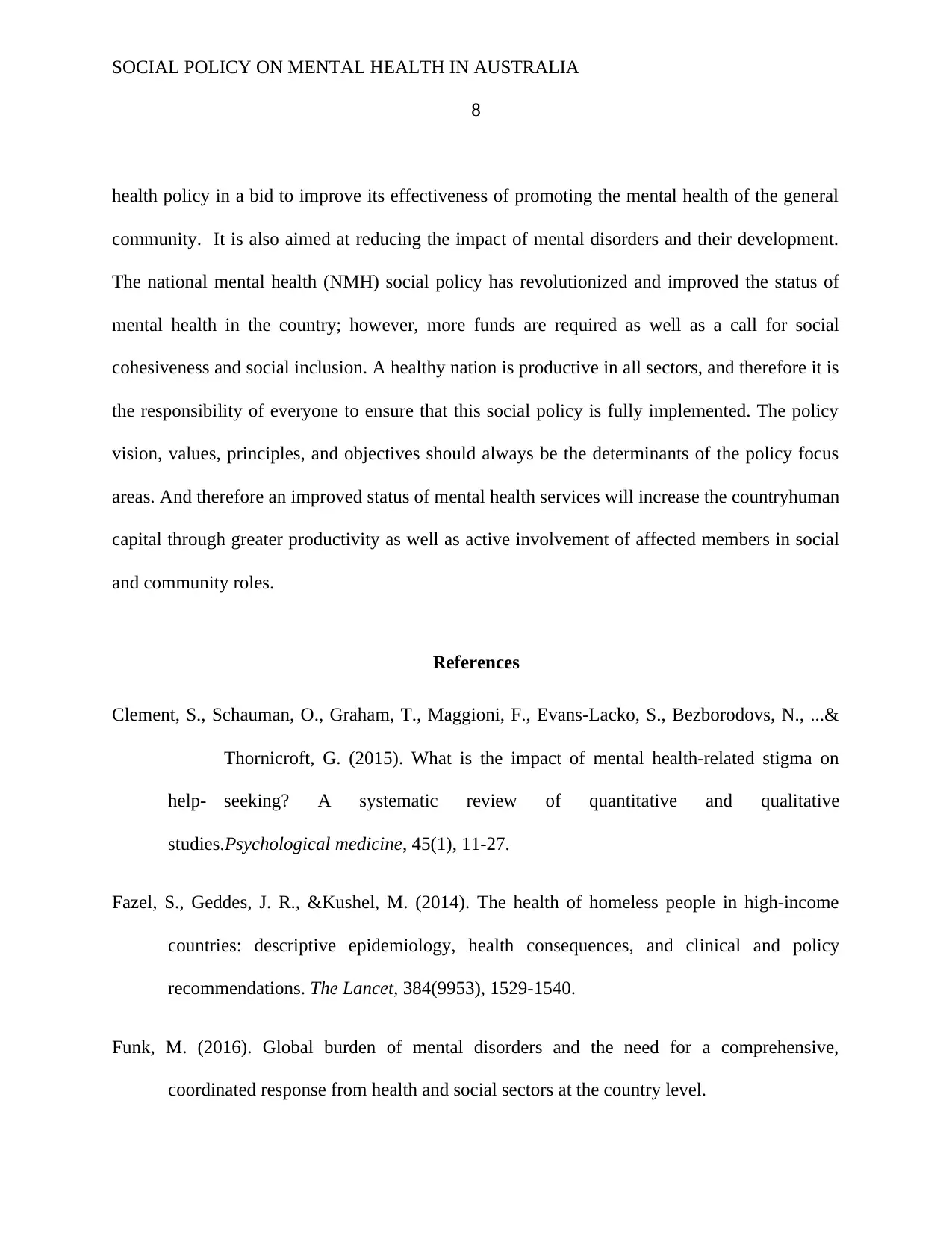
SOCIAL POLICY ON MENTAL HEALTH IN AUSTRALIA
8
health policy in a bid to improve its effectiveness of promoting the mental health of the general
community. It is also aimed at reducing the impact of mental disorders and their development.
The national mental health (NMH) social policy has revolutionized and improved the status of
mental health in the country; however, more funds are required as well as a call for social
cohesiveness and social inclusion. A healthy nation is productive in all sectors, and therefore it is
the responsibility of everyone to ensure that this social policy is fully implemented. The policy
vision, values, principles, and objectives should always be the determinants of the policy focus
areas. And therefore an improved status of mental health services will increase the countryhuman
capital through greater productivity as well as active involvement of affected members in social
and community roles.
References
Clement, S., Schauman, O., Graham, T., Maggioni, F., Evans-Lacko, S., Bezborodovs, N., ...&
Thornicroft, G. (2015). What is the impact of mental health-related stigma on
help- seeking? A systematic review of quantitative and qualitative
studies.Psychological medicine, 45(1), 11-27.
Fazel, S., Geddes, J. R., &Kushel, M. (2014). The health of homeless people in high-income
countries: descriptive epidemiology, health consequences, and clinical and policy
recommendations. The Lancet, 384(9953), 1529-1540.
Funk, M. (2016). Global burden of mental disorders and the need for a comprehensive,
coordinated response from health and social sectors at the country level.
8
health policy in a bid to improve its effectiveness of promoting the mental health of the general
community. It is also aimed at reducing the impact of mental disorders and their development.
The national mental health (NMH) social policy has revolutionized and improved the status of
mental health in the country; however, more funds are required as well as a call for social
cohesiveness and social inclusion. A healthy nation is productive in all sectors, and therefore it is
the responsibility of everyone to ensure that this social policy is fully implemented. The policy
vision, values, principles, and objectives should always be the determinants of the policy focus
areas. And therefore an improved status of mental health services will increase the countryhuman
capital through greater productivity as well as active involvement of affected members in social
and community roles.
References
Clement, S., Schauman, O., Graham, T., Maggioni, F., Evans-Lacko, S., Bezborodovs, N., ...&
Thornicroft, G. (2015). What is the impact of mental health-related stigma on
help- seeking? A systematic review of quantitative and qualitative
studies.Psychological medicine, 45(1), 11-27.
Fazel, S., Geddes, J. R., &Kushel, M. (2014). The health of homeless people in high-income
countries: descriptive epidemiology, health consequences, and clinical and policy
recommendations. The Lancet, 384(9953), 1529-1540.
Funk, M. (2016). Global burden of mental disorders and the need for a comprehensive,
coordinated response from health and social sectors at the country level.
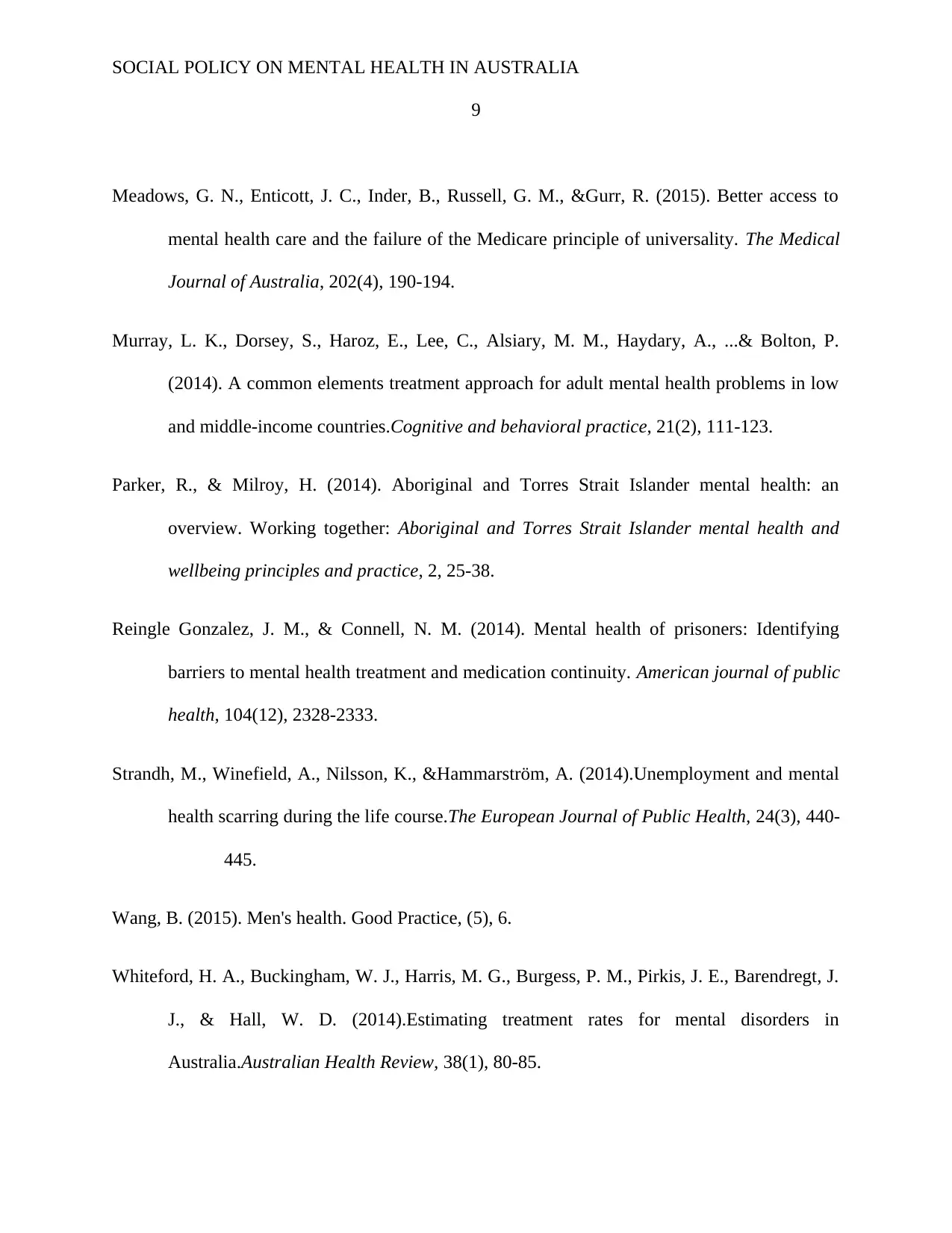
SOCIAL POLICY ON MENTAL HEALTH IN AUSTRALIA
9
Meadows, G. N., Enticott, J. C., Inder, B., Russell, G. M., &Gurr, R. (2015). Better access to
mental health care and the failure of the Medicare principle of universality. The Medical
Journal of Australia, 202(4), 190-194.
Murray, L. K., Dorsey, S., Haroz, E., Lee, C., Alsiary, M. M., Haydary, A., ...& Bolton, P.
(2014). A common elements treatment approach for adult mental health problems in low
and middle-income countries.Cognitive and behavioral practice, 21(2), 111-123.
Parker, R., & Milroy, H. (2014). Aboriginal and Torres Strait Islander mental health: an
overview. Working together: Aboriginal and Torres Strait Islander mental health and
wellbeing principles and practice, 2, 25-38.
Reingle Gonzalez, J. M., & Connell, N. M. (2014). Mental health of prisoners: Identifying
barriers to mental health treatment and medication continuity. American journal of public
health, 104(12), 2328-2333.
Strandh, M., Winefield, A., Nilsson, K., &Hammarström, A. (2014).Unemployment and mental
health scarring during the life course.The European Journal of Public Health, 24(3), 440-
445.
Wang, B. (2015). Men's health. Good Practice, (5), 6.
Whiteford, H. A., Buckingham, W. J., Harris, M. G., Burgess, P. M., Pirkis, J. E., Barendregt, J.
J., & Hall, W. D. (2014).Estimating treatment rates for mental disorders in
Australia.Australian Health Review, 38(1), 80-85.
9
Meadows, G. N., Enticott, J. C., Inder, B., Russell, G. M., &Gurr, R. (2015). Better access to
mental health care and the failure of the Medicare principle of universality. The Medical
Journal of Australia, 202(4), 190-194.
Murray, L. K., Dorsey, S., Haroz, E., Lee, C., Alsiary, M. M., Haydary, A., ...& Bolton, P.
(2014). A common elements treatment approach for adult mental health problems in low
and middle-income countries.Cognitive and behavioral practice, 21(2), 111-123.
Parker, R., & Milroy, H. (2014). Aboriginal and Torres Strait Islander mental health: an
overview. Working together: Aboriginal and Torres Strait Islander mental health and
wellbeing principles and practice, 2, 25-38.
Reingle Gonzalez, J. M., & Connell, N. M. (2014). Mental health of prisoners: Identifying
barriers to mental health treatment and medication continuity. American journal of public
health, 104(12), 2328-2333.
Strandh, M., Winefield, A., Nilsson, K., &Hammarström, A. (2014).Unemployment and mental
health scarring during the life course.The European Journal of Public Health, 24(3), 440-
445.
Wang, B. (2015). Men's health. Good Practice, (5), 6.
Whiteford, H. A., Buckingham, W. J., Harris, M. G., Burgess, P. M., Pirkis, J. E., Barendregt, J.
J., & Hall, W. D. (2014).Estimating treatment rates for mental disorders in
Australia.Australian Health Review, 38(1), 80-85.
⊘ This is a preview!⊘
Do you want full access?
Subscribe today to unlock all pages.

Trusted by 1+ million students worldwide
1 out of 9
Related Documents
Your All-in-One AI-Powered Toolkit for Academic Success.
+13062052269
info@desklib.com
Available 24*7 on WhatsApp / Email
![[object Object]](/_next/static/media/star-bottom.7253800d.svg)
Unlock your academic potential
Copyright © 2020–2025 A2Z Services. All Rights Reserved. Developed and managed by ZUCOL.




